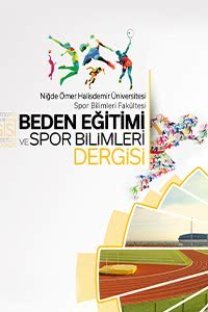TÜM VÜCUT VİBRASYON UYARANLARINA MERKEZİ KONTROL SİSTEMİ NASIL ADAPTE OLUR
Araştırmanın amacı yüksek ve düşük frekanslı akut tüm vücut vibrasyon [TVV] uyaranlarının postural kontrol yetenekleri üzerine olan ektilerinin incelenmesidir. Anadolu Üniversitesi Spor Bilimleri Fakültesinde öğrenci olan 16 erkek çalışmaya gönüllü olarak katılmıştır. TBV uyarıları şu parametreler izlenerek uygulanmıştır: (1) frekans: 30 ve 40 Hz: (2) duruş: statik squat pozisyonu:(3)genlik: 4mm: (4) diz fleksiyon açısı: 120o: süresi: 60sn. Medio-lateral yer reaksiyon kuvvetİ (MLYRK) ve anterio-posterior yer reaksiyon kuvvetİ (APYRK) kuvvet platformu ile ölçüldü. 4mm genlikte düşük ve yüksek frekanslı TVV uyaranları farklı postural adaptasyonlarla sonuçlanmıştır (p
HOW THE CENTRAL CONTROL SYSTEM ADAPTS TO ACUTE WHOLE-BODY VIBRATION STIMULUS
This study investigated the effects of high- and low-frequency acute whole-body vibration (WBV) on postural control ability. Sixteen male students from the Faculty of Sport Science voluntarily participated in this study. [Methods] WBV stimuli were applied using the following parameters: (1) frequency: 30 or 40 Hz; (2) stance: static squat position; (3) amplitude: 4 mm; (4) knee flexion angle: 120°; and duration: 60 s. The medio-lateral ground reaction force (MLGRF) and anterio-posterior ground reaction force (APGRF) were measured on a force platform. The results showed that static WBV stimulation at 4 mm in amplitude at low and high frequencies resulted in different postural adaptations (p<0.05). The APGRF and MLGRF were higher at 30 Hz than at 40 Hz, and a rapid exponential decline in the post-vibration values was observed within the first 10 seconds of stimulation at 30 Hz or 40 Hz at 4 mm. After the initial 10 seconds, these forces were maintained until the end of the 60-second stimulation period. The present findings support that somatosensory stimulation at 30 Hz and 4 mm induced long-term effects on the control of postural sway. Alternatively, somatosensory stimulation more rapidly adapted to the vibration at 40 Hz and 4 mm. It may be concluded that WBV at 40 Hz and 4 mm can rapidly provide beneficial effects to the elderly, for whom postural control is very important, for the treatment of chronic conditions such as Parkinson's disease, osteoporosis, and post-menopausal conditions or for the enhancement of athletic performance.
___
- 1. Maurer C, Mergner T, Bolha B , Hlavacka , F. Vestibular, visual, and somatosensory contributions to human control of upright stance. Neurosci Lett, 2000, Mar 10;281(2-3):99-102.
- 2. Peterka RJ. Sensorimotor integration in human postural control. J Neurophysiol, 2002, Sep;88(3):1097-118
- 3. Horak FB, Macpherson JM. Postural orientation and equilibrium. Exercise: regulation and integration of multiple systems. In: Shepherd J, Rowell L, eds. Handbook of physiology. New York: Oxford University, 1996, pp 255-292.
- 4. Nashner LM. Practical Management of the Dizzy Patient. In: Computerized dynamic posturography. Lippincott Williams & Wilkins, 2001, pp 143-170.
- 5. Hayashi R, Miyake A, Watanabe S. The functional role of sensory inputs from the foot: stabilizing human standing posture during voluntary and vibrationinduced body sway. Neurosci Res, 1998, Feb;5(3):203-13.
- 6. Adamcová N, Hlavacka F: Human postural responses to leg muscle vibration altered by visual scene motion. Physiol Res, 2004, (Suppl. 1): S129- S134, 2006
- 7. Hassan BS, Mockett S, Doherty M: Static postural sway, proprioception, and maximal voluntary quadriceps contraction in patients with knee osteoarthritis and normal control subjects. Ann Rheum Dis, 2001, Jun; 60(6): 612-618.
- 8. Latash ML, Postural control. In: Neurophysiological Basis of Movement. Champaign: Human Kinetics, 1998, pp163-194.
- 9. Lephart SM, Freddie H. Proprioception and neuromuscular control in joint stability. Champaign: Human Kinetics, 2000, pp 23-28.
- 10. Klonoff PS, Costa LD, Snow WG. Predictors and indicators of quality of life in patients with closedhead injury. J Clin Exp Neuropsychol, 1986, Oct;8(5):469-85.
- 11. Kenney WL, Wilmore J, Costill L: Physiology of Sport and Exercise. Human Kinetics, Fifth Edition, 2011 pp 81-87.
- 12. Roll J.P, Vedel J.P, Ribot E: Alteration of proprioceptive messages induced by tendon vibration in man - a microneurographic study. Experimental Brain Research, 1989, 76(1):213-22
- 13. Prochazka A, Gillard D, and Bennett DJ: Implications of positive feedback in the control of movement. J Neurophysiol, 1997, Jun;77(6):3237- 51.
- 14. Rosenbaum, DA: Human motor control, San Diego, CA: Academic Press, 1991, ch. 4.
- 15. Visser JE, Bloem BR: Role of the basal ganglia in balance control. Neural Plast, 2005, Volume 12, Issue 2-3, Pages 161-174.
- 16. Wierzbicka MM, Gilhodes JC, Roll JP: Vibrationinduced postural Posteffects. J Neurophysiol, 1998, Jan;79(1):143-50
- 17. Kavounoudias A, Gilhodes J, Roll R, Roll JP. From balance regulation to body orientation: two goals for muscle proprioceptive information processing? Exp Brain Res, 1999, Jan;124(1):80-8.
- 18. Kavounoudıas A, Roll R, Roll J: Specific whole-body shifts induced by frequency-modulated vibrations of human plantar soles. N eurosci Lett, 1999, May 14;266(3):181-4.
- 19. Gilhodes JC, Roll JP, Tardy-Gervet MF: Perceptual and motor effects of agonist-antagonist muscle vibration in man. Exp Brain Res, 1986, 61(2):395- 402.
- 20. Burke D, Hagbarth KE, Löfstedt L, Wallin BG. The responses of human muscle spindle endings to vibration of non-contracting muscles. J Physiol, 1976, Oct;261(3):673-93.
- 21. Gilhodes JC, Gurfinkel VS, Roll JP: Role of Ia muscle spindle afferents in post-contraction and post -vibration motor effect genesis. Neurosci Lett,1992, Feb 3;135(2):247-51
- 22. Eklund G: General features of vibration-induced effects on balance. Ups J Med Sci, 1972, 77(2):112- 24.
- ISSN: 1307-6477
- Yayın Aralığı: Yılda 3 Sayı
- Başlangıç: 2007
- Yayıncı: Niğde Üniversitesi Beden Eğitimi ve Spor Yüksek Okulu
Sayıdaki Diğer Makaleler
TENİS OYUNUNUN İNTERNAL & EKSTERNAL OMUZ PROPRİYOSEPSİYONUNA VE OMUZ KAS KUVVETİNE ETKİSİ
AHMET YIKILMAZ, MÜRSEL BİÇER, ALPER CENK GÜRKAN, MUSTAFA ÖZDAL
ÇALIK VELİ KOÇAK, Serap ASLİM TÜFEKÇİ
EFFECTS OF SIX-WEEK ENDURANCE TRAINING METHOD ON SOME HAEMATOLOGICAL VALUES OF BASKETBALL PLAYERS
İSTANBUL GENÇLİK HİZMETLERİ VE SPOR MÜDÜRLÜĞÜ PERSONELİNİN SİNİZM DÜZEYLERİNİN İNCELENMESİ
Abdurrahman KEPOĞLU, M. Zahit SERARSLAN, AHMET NUSRET BULGURCUOĞLU, Serkan ÖÇALMAZ, Ekrem ALBAYRAK
TÜM VÜCUT VİBRASYON UYARANLARINA MERKEZİ KONTROL SİSTEMİ NASIL ADAPTE OLUR
Deniz ŞİMŞEK, İZZET KIRKAYA, A. Ruhi SOYLU, Olgun UGURLU, ALİ ONUR CERRAH, HAYRİ ERTAN
